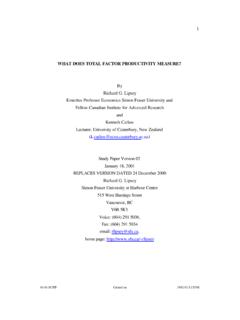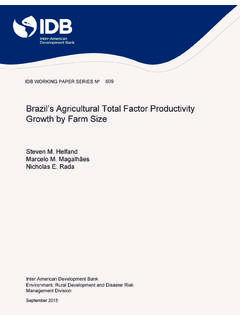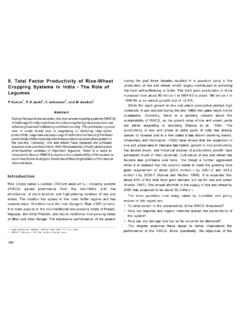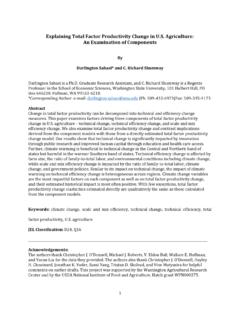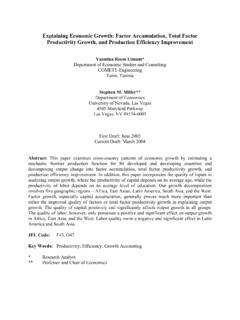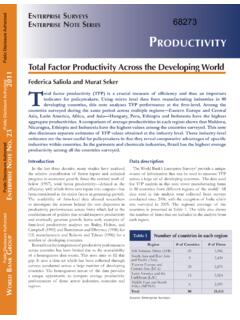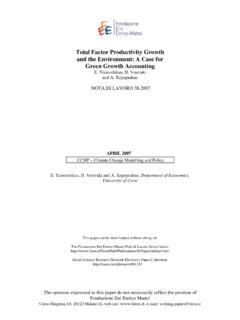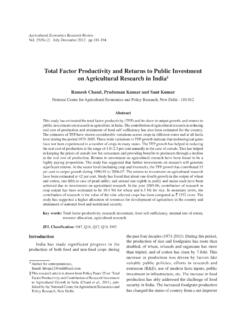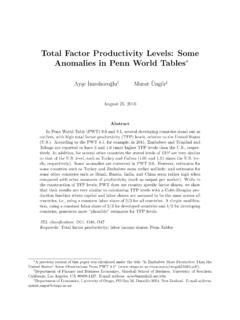Transcription of Total Factor Productivity, Saving Rate and Learning-by ...
1 Total Factor productivity , Saving Rate andLearning-by-Doing in Growth ProcessCuong Le Van ,Tu-Anh NguyenyMarch 19, 2009 AbstractIn transitional stage Saving rate play an important role in outputgrowth rate as proposed by Krugman. Accumulationists are also rightas claiming that Learning-by -doing play an important role in TFP growthin NIEs. However, using a CES production technology we can show thatthe growth model based purely on Learning-by -doing is constrained by la-bor growth rate. If the latter is constant in the long-run, then the growthcan not be :Optimal growth model, Learning-by -doing, Saving rate, De-veloping Classi cation:D51, E13, E211 IntroductionThe roles of capital accumulation and technological progress in economic growthare not new stories in the literature.
2 The Solow (1956) based on the classicalassumption of diminishing returns to capital, states that without continuing im-provement of technology per capita growth must eventually cease. The essentialfactor for economic growth, namely technological progress, is however, exoge-nous to the model. This shortcoming inspires scholars such as Romer (1986,1987, 1990), Lucas (1988), Rebelo (1991), Grossman and Helpman (1991),Aghion and Howitt (1992) and many others to develop new "endogenous"growth models which provide more insight into the Solow s residual. The en-dogenous growth models by taking human capital accumulation, Learning-by -doing, research and development (R&D), and knowledge spillover in economic CNRS, University Paris 1, PSE, CESyUniversity Paris 1, CNRS, CES1growth into account are able to generate long-term per-capita growth , the spectacularly rapid growth of many Asian economies, espe-cially the East Asian newly industrialized economies (NIEs) gave rise to a broadand diversi ed literature aiming at explaining the reasons for such a long lastingperiod of expansion (Kim and Lau [1994, 1996], Krugman [1994], Rodrik [1995],Worldbank [1993], Young [1994, 1995]).
3 All these economies have experiencedrapid growth of their physical capital stock and very high rate of investment inhuman one hand, the supporters of the accumulation view stress the impor-tance of physical and human capital accumulation in the Asian growth , the main engine of "miracle growth" in NIEs is simply, very highinvestment rates . Young [1994, 1995], Kim and Lau [1994, 1996] found that thepostwar economic growth of the NIEs was mostly due to growth in input factors (physical capital and labor) with trivial increase in the Total Factor productiv-ity. Moreover, the hypothesis of no technical progress cannot be rejected for theEast Asian NIEs (Kim and Lau [1994]). Consequently, accumulation of phys-ical and human capital seems to explain the lion s share of the NIEs growthprocess.
4 Krugman [1997] wrote that Larry Lau and Alwyn Young works sug-gested that Asian growth could mostly be explained by high investment rates ,good education and the movement of underemployment peasants into the mod-ern sector. Economists who take this point implicitly assumed that adoptionand mastering new technology and other modern practices could be done easilyby trade."Accumulationists seem to believe that the state of technological knowledgeat any time is largely codi ed in the form of blueprints and associated documentsand that, for a rm to adopt a technology that is new to it but not to the world,primarily involves getting access to those blueprints" (Nelson and Pack, 1998).Accordingly, any economies could have experienced high rates of growthlike NIEs if they could a ord similar investment rates .
5 Krugman s [1994] in-terpretation of these results is very pessimistic since, in his opinion, the lack oftechnical progress will inevitably bound the growth engine of East Asian NIEsas a result of the diminishing returns a ecting capital the other hand, the supporters of endogenous growth theory pinpointproductivity growth as the key Factor of East Asian success. According to theseauthors, Asian countries have adopted technologies previously developed bymore advanced economies (assimilation view) and "the source of growth in afew Asian economies was their ability to extract relevant technological knowledgefrom industrial economies and utilize it productively within domestic economy"(Pack [1992]). They admit that high rates of investment into physical and2human capital is necessary to achieve high economic growth rate.
6 However, asstressed by Nelson and Pack (1998) there is nothing automatic in learning about,in risking to operate and, in coming to master technologies and other practicesthat are new to the economy. These processes require searching and studying, learning , and innovating to master modern technologies and new , the economy enhances its stock of knowledge and e ciency. Implicitly,they suggest that technological progress exists and does play a crucial role inNIEs economic , Collins and Bosworth [1996] or Lau and Park [2003] show TotalFactor productivity (TFP) gains actually matter in Asian NIEs growth andthat future growth can be sustained. For these authors, Learning-by -doing inprocess of physical accumulation play an essential role in TFP growth in this paper we prove that Krugman s view is correct in the short andmid terms.
7 But in the long term, TFP is the main Factor of growth. In thissense, Solow is right and his 1956 model is basically a long term growth cally, in transitional stage the high Saving rate induces high growth rateof output however, in the long-run the impact of Saving rate on output growthrate will vanish the other hand, assimilationists are also right as claiming that Learning-by -doing play an important role in TFP growth in NIEs. We also show, however,that the growth model based purely on Learning-by -doing is constrained by laborgrowth rate. If the latter is constant in the long-run, then the growth can notbe sustained. Therefore, despite Learning-by -doing generating TFP growth thelong run growth essentially requires in-house capacity to generate , if the structure of the economy is not elastic, in the sense that it isnot easy to switch from a labor-intensive technology to more capital-intensivetechnologies and vise versa, then Saving plays a crucial role in economic economy may fall into poverty trap if Saving rate is too low or the pop-ulation grows too fast, regardless how e ective the knowledge accumulation( Learning-by -doing and spilling-over) organization of the paper is as follows.
8 The general basic neoclassicalmodel is presented in section 2. In section 3 we use standard Solow modelto prove that high investment rate improve growth rate in short-term howeverthis e ect vanish in long-term. In section 4, CES production function is used totake into account process of knowledge accumulation through Learning-by -doingand the spillover in economic growth process. The last section summarize mainresults of the The Basic Neoclassical ModelIn this section we set out the basic model of capital accumulation that will usein our analysis. The standard constant return to scale is de ned as follows:Yt=F(At; Kt; Lt)(1)WhereYtis output,Ktis physical capital,Ltis labour input,Atis a pa-rameter of technological progress.
9 The production function, ifAtandLtareconstant, has positive and diminishing returns to the reproducible factorKt:Mathematically,@Yt@KT>0;@2Yt@Kt @Kt<0:We follow Sollow (1956) to assume that Saving (net investment) is a xedfractionsof income; the capital stock depreciates at a xed rate ;and thelabor growth rate is constant atn. With these assumptions the transitionaldynamics of the model is given by following program:Ct+St=Yt=F(At; Kt; Lt)(2a)St=sYt; sis the exogenous Saving rateKt+1=Kt(1 ) +sYt(2b)Lt=L0(1 +n)tCt; St; Yt; Kt; It; Ltdenote respectively the consumption, the Saving , the out-put, the capital stock, the investment and the labour at periodt. The labourforce grows with an exogenous raten: Atdenotes the technological level in theeconomy at timet.
10 The growth rate ofAtis assumed to be identical with thegrowth rate of the Total Factor productivity (TFP).In the following section we use Solow model to show that in short run invest-ment rate or physical capital accumulation do have strong e ect on economicgrowth. However, in long-run economic growth is neutral to investment ratebut positively contingent on rate of technological accumulating knowledge through Learning-by -doing as mentioned inAtkinson and Stiglitz (1969) and Nelsons and Pack (1998) is modelized in aCES production function in section Exogenous TFP: The Solow ModelIn this section we use Cobb-Douglas functional to consider a simple intertem-poral growth model for a closed (1 + )tK tL1 t;0< <1(3)4 The Total Factor productivity (TFP) is assumed to grows at a constant rate.


